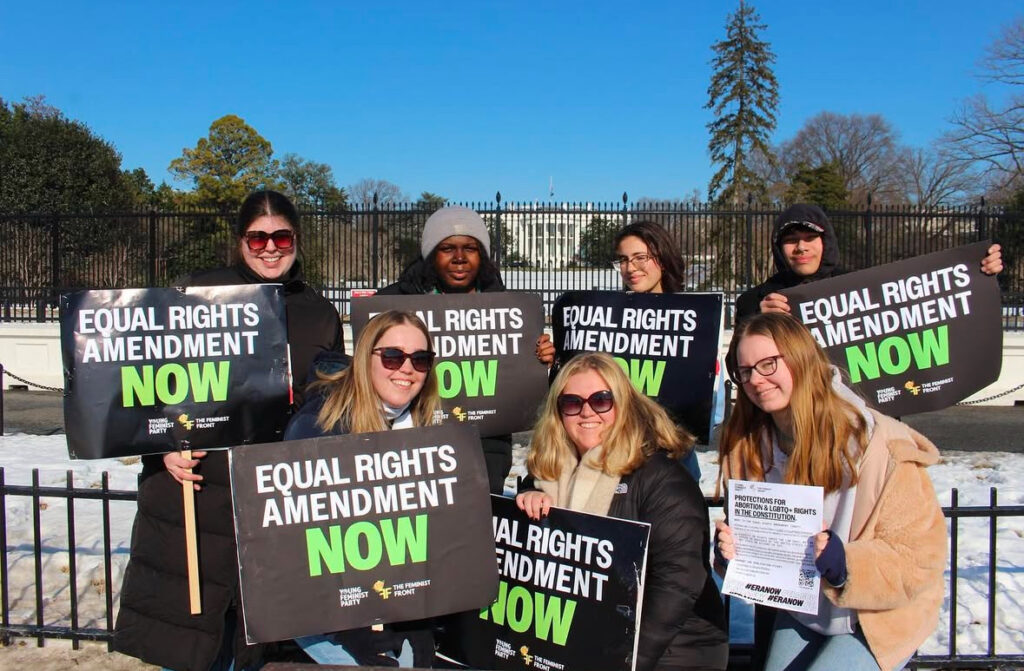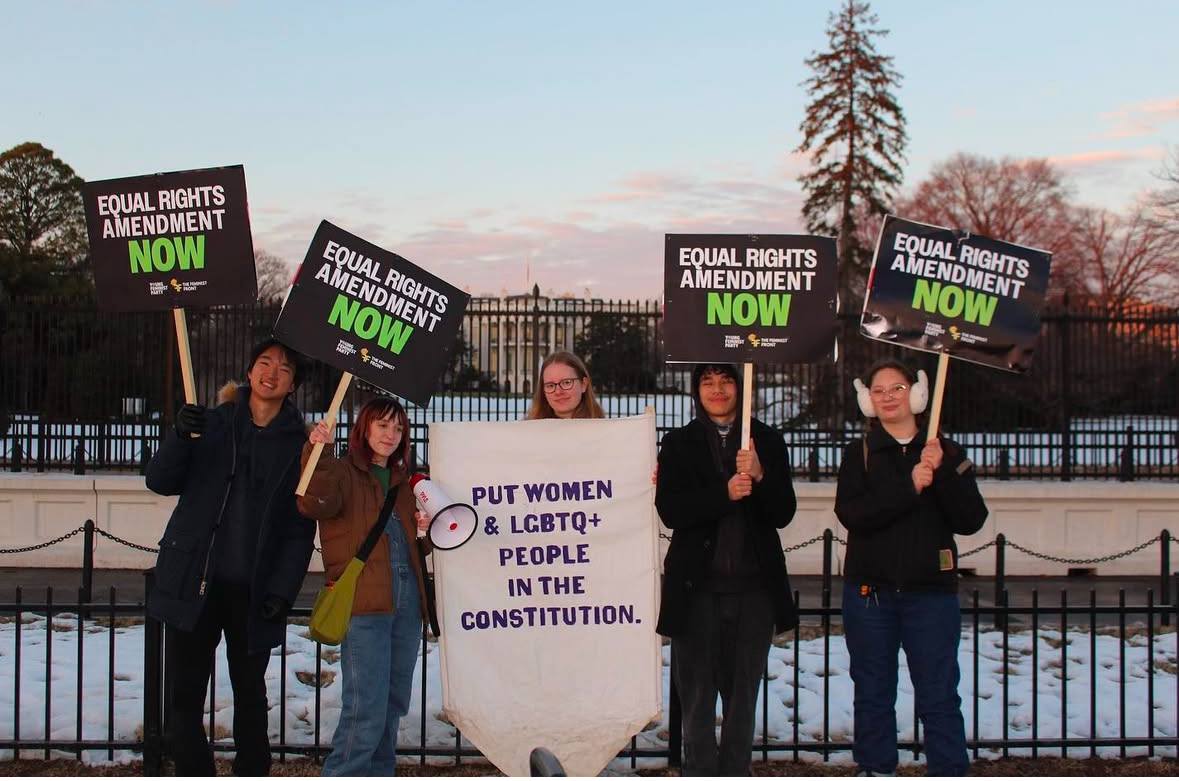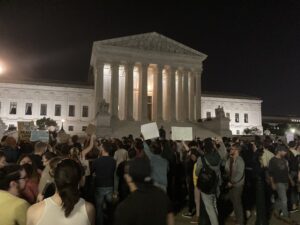On Jan. 17, former President Biden declared the Equal Rights Amendment (ERA), a constitutional amendment prohibiting sex-based discrimination, to be the 28th amendment to the Constitution. The move was largely symbolic—presidents cannot certify amendments on their own—and followed days of student activism across the country and in D.C. Now, these student activists are considering their next move under the Trump administration.
The ERA was first proposed in 1923 and, if adopted, would enshrine protections against sex-based discrimination in the law in the Constitution. While the amendment passed the Senate in 1972, it was not ratified by the necessary 38 states by the 1982 deadline set by Congress.
Some activists have argued that the ERA should have been law since 2020, when Viriginia became the 38th state to ratify the amendment, 38 years after the deadline and almost a century after the amendment was first introduced. “38 states and 100 damn years” became a rallying cry for the Young Feminist Party, one of the groups that took to the streets in D.C. to advocate for the ERA ahead of President Trump’s inauguration in January.
Student activists from organizations within the ERA Coalition, a group dedicated to promoting the ERA across organizations, spent the final days of the Biden administration urging the president and the national archivist to publish the ERA. The national archivist publishes the federal register, the official legal journal of the federal government.
Ansuya Bisbey, a junior at Richard Montgomery High School in Rockville, Maryland and a member of the Maryland Board of the Young Feminist Party, remembers how she felt the night before Biden’s declaration.
“We were really excited. I remember I was crying, telling my mom, ‘I don’t know what’s gonna happen. I don’t know what he’s going to say,’” Bisbey said.
Sara Holler (CAS ’28), another organizer with the Young Feminist Party, spent days protesting outside the White House in hopes of garnering Biden’s support for the ERA. Holler told the Voice Biden’s statement was a win for activists, but came too late to create real change.
“A president openly stating the validity of the ERA is a huge step for the movement,” Holler wrote to the Voice. “If [Biden] had acted sooner there is a chance it would be published already,”

Photo courtesy of Sara Holler Holler and others picket outside the White House.Photo courtesy of Sara Holler
After Biden’s announcement, the protestors’ focus shifted to the national archivist, inspiring protests outside of the National Archives. Holler estimates that the crowd grew from 10 students per day when protests began on Jan. 8 outside the White House to 50 students on Jan. 17, the day of their protest at the National Archives. Other organizations from the ERA Coalition, including the Feminist Front and the Women’s March, joined the Young Feminist Party in the protests.
Toward the tail end of 2024, the national archivist and deputy archivist put forth a joint public statement saying they would not publish the ERA given that Congress’ 1982 deadline for ratification had long since passed. Shogan stuck to this stance after Biden’s declaration.
Holler told the Voice that once it became clear on Jan. 17 that Shogan would not publish the amendment, protestors shut down Constitution Avenue outside of the National Archives holding a banner that read, “We demand #ERANOW/Put us in the Constitution” and “ERA Yes.”

Photo courtesy of Sara Holler Holler joins other activists in a protest, stopping traffic on Constitution Ave.Photo courtesy of Sara Holler
Some legal experts agree with ERA activists that Shogan had the constitutional power to publish the amendment. The American Bar Association (ABA) passed a resolution in support of the ERA in August 2024, writing that the original time limit for ratification in the ERA was unconstitutional.
The ABA resolution notes that current protections against sex-based discrimination are subject to political change. Presidents can choose whether to enforce certain anti-discrimination statutes, judges can overrule past landmark rulings, and legislators can amend or abolish the protections that currently exist.
“By explicitly embedding gender equality in the Constitution, the ERA would ensure the legal rights of all women and LGBTQ+ individuals are shielded, irrespective of what political party is in office,” they wrote.
Looking forward, ERA activists see the second Trump administration as a major obstacle to their efforts.
Shortly after his inauguration, the Trump administration took down the White House webpage that featured Biden’s ERA proclamation. Trump also revoked a 60-year-old executive order prohibiting federal contractors from engaging in discrimination based on race, sex, and other protected criteria.
The recent actions of the Trump administration frighten student protesters.
“I was very nervous. I’m still very nervous with the new administration. There’s all sorts of executive orders and bills being introduced to kind of silence queer people, women, and ban reproductive freedom,” Bisbey said.
Holler pointed to several paths forward for the ERA movement, saying that focusing on passing amendments to state constitutions may be the next best option.
“While the publication of the federal ERA is the ultimate goal, there are so many actions we can take to ensure publication of state ERAs,” Holler wrote.
28 states already have state-level amendments prohibiting sex discrimination. State amendments are also often more comprehensive than proposed federal legislation, and include categories such as race, gender identity, sexual orientation, age, and disability status in addition to sex.
In New York, the most recent state to pass a state ERA, the amendment helped enshrine reproductive rights in the state’s constitution by including pregnant people as a category of identity that cannot be discriminated against.
Even as student activists turn their focus to state-level advocacy, Bisbey said they will still keep their eyes on the possibility of a national ERA in the future.
“Having that legal protection and actually putting this in the Constitution, not only is it symbolic but it would change laws and allow for a lot of laws to be put in place to emphasize equality,” Bisbey said.
The Young Feminist Party plans to continue to fight for feminist policies, using electoral organizing and judicial advocacy.
“We’re not going into hiding now that the Trump Administration is here,” Bisbey said.
Holler added that activists have many goals beyond the ERA.
“Although the passage of the ERA is important, it is equally as important to continue upholding its principles of equality and holding Trump’s administration accountable,” Holler wrote.
Bisbey emphasized that there is power in numbers, and encouraged other activists to continue organizing to fight for their beliefs.
“The new administration, the Trump administration, is a threat to everything,” she said. “It’s not just a threat to women’s rights. It’s a threat to climate rights, it’s a threat to immigrants. So my message would just be to stand together. There’s power in organizing, and if you really put in the work, things will happen.”





